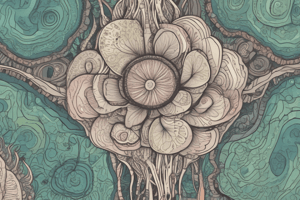Podcast
Questions and Answers
¿Cuál es un aspecto característico de los organismos pluricelulares?
¿Cuál es un aspecto característico de los organismos pluricelulares?
- Reflejan la diversidad y complejidad de la vida en la Tierra. (correct)
- Tienen una estructura y función simple.
- Son seres unicelulares.
- Han evolucionado por miles de años hacia seres unicelulares.
¿Qué característica destaca a los tejidos vegetales?
¿Qué característica destaca a los tejidos vegetales?
- Su incapacidad para fotosintetizar.
- Su falta de adaptabilidad a diferentes entornos.
- La complejidad y adaptabilidad de sus tejidos a diversos entornos. (correct)
- La simplicidad de sus células y estructuras.
¿Cuál de las siguientes NO es una característica de los animales invertebrados?
¿Cuál de las siguientes NO es una característica de los animales invertebrados?
- Presentan una diversidad de estructuras y comportamientos.
- Ocupan una amplia variedad de ecosistemas.
- Todos tienen columna vertebral. (correct)
- Pueden incluir insectos sociales y crustáceos.
¿Qué relación existe entre los tejidos animales y las formas y funciones de los animales?
¿Qué relación existe entre los tejidos animales y las formas y funciones de los animales?
¿Cuál es una afirmación verdadera sobre el reino animal?
¿Cuál es una afirmación verdadera sobre el reino animal?
¿Cuál es una característica distintiva del reino animal según el texto?
¿Cuál es una característica distintiva del reino animal según el texto?
¿Qué tipo de simetría tienen las medusas, según el texto?
¿Qué tipo de simetría tienen las medusas, según el texto?
¿Qué contribuyen las revistas Biologia y Biologia Plantarum al estudio de la diversidad de la vida?
¿Qué contribuyen las revistas Biologia y Biologia Plantarum al estudio de la diversidad de la vida?
¿Qué tipo de células forman los tejidos del corazón humano, según el texto?
¿Qué tipo de células forman los tejidos del corazón humano, según el texto?
¿Cuál es una característica común de los animales invertebrados según el texto?
¿Cuál es una característica común de los animales invertebrados según el texto?
Flashcards are hidden until you start studying
Study Notes
Exploring Life's Diversity: Organismos Pluricelulares, Tejidos Vegetales, Animales Invertebrados, Tejidos Animales, Reino Animal
Life, as we know it, is a thoroughly diverse and intricate tapestry, woven with organisms that exhibit a remarkable array of structures and functions. Let's delve into some of the most fascinating aspects of this tapestry, focusing on multicellular organisms, plant tissues, invertebrate animals, animal tissues, and the animal kingdom itself.
Organismos Pluricelulares
Organisms composed of multiple cells are the backbone of life on Earth. The complexity of these organisms, such as ourselves, is a testament to the evolutionary forces that have shaped life for millions of years.
Tejidos Vegetales
Plants are among the oldest and most diverse organisms on Earth. Their tissues are adaptive to diverse environments and display remarkable complexity. From the chloroplast-filled mesophyll cells of leaves to the specialized cells of roots and stems, plants are marvels of architecture and function.
Animales Invertebrados
Invertebrates are animals that lack a backbone or a vertebral column. They are diverse and abundant, occupying almost every ecological niche on our planet. They display a wide range of structures and behaviors, from the social insects and the mollusks to the arthropods, which include spiders, scorpions, and crustaceans.
Tejidos Animales
The tissues that make up animals are as varied as their forms and functions. From the muscle cells of the human heart to the photoreceptor cells in the compound eyes of insects, animal tissues are the building blocks of life's most complex structures.
Reino Animal
This realm encompasses all living organisms that possess distinct animal characteristics, such as multicellularity, heterotrophy, and ability to respond to external stimuli. Animals possess a diverse array of body plans, ranging from the bilateral symmetry of humans to the radial symmetry of jellyfish.
Throughout history, our knowledge of life's diversity has grown and continues to expand. Biology journals such as Biologia and Biologia Plantarum help us in this pursuit, with their coverage of microbial, plant, and animal sciences. The Guardian and Phys.org are additional sources of recent scientific discoveries that contribute to our understanding of life's complexity.
As we continue to explore life's diverse tapestry, we not only uncover the secrets of our past and present but also glimpse into the future of life on Earth, shaping our world for generations to come.
Studying That Suits You
Use AI to generate personalized quizzes and flashcards to suit your learning preferences.




